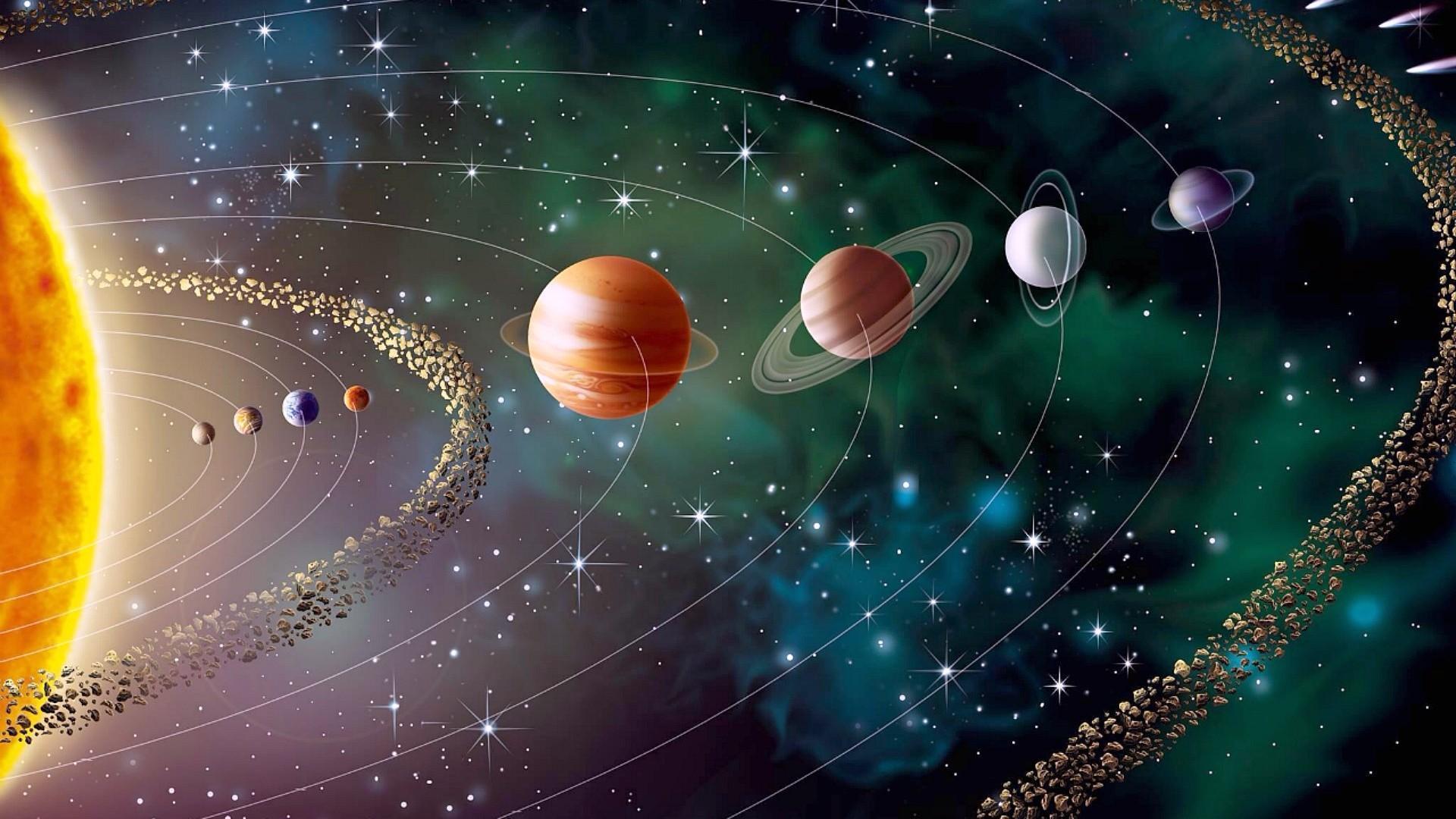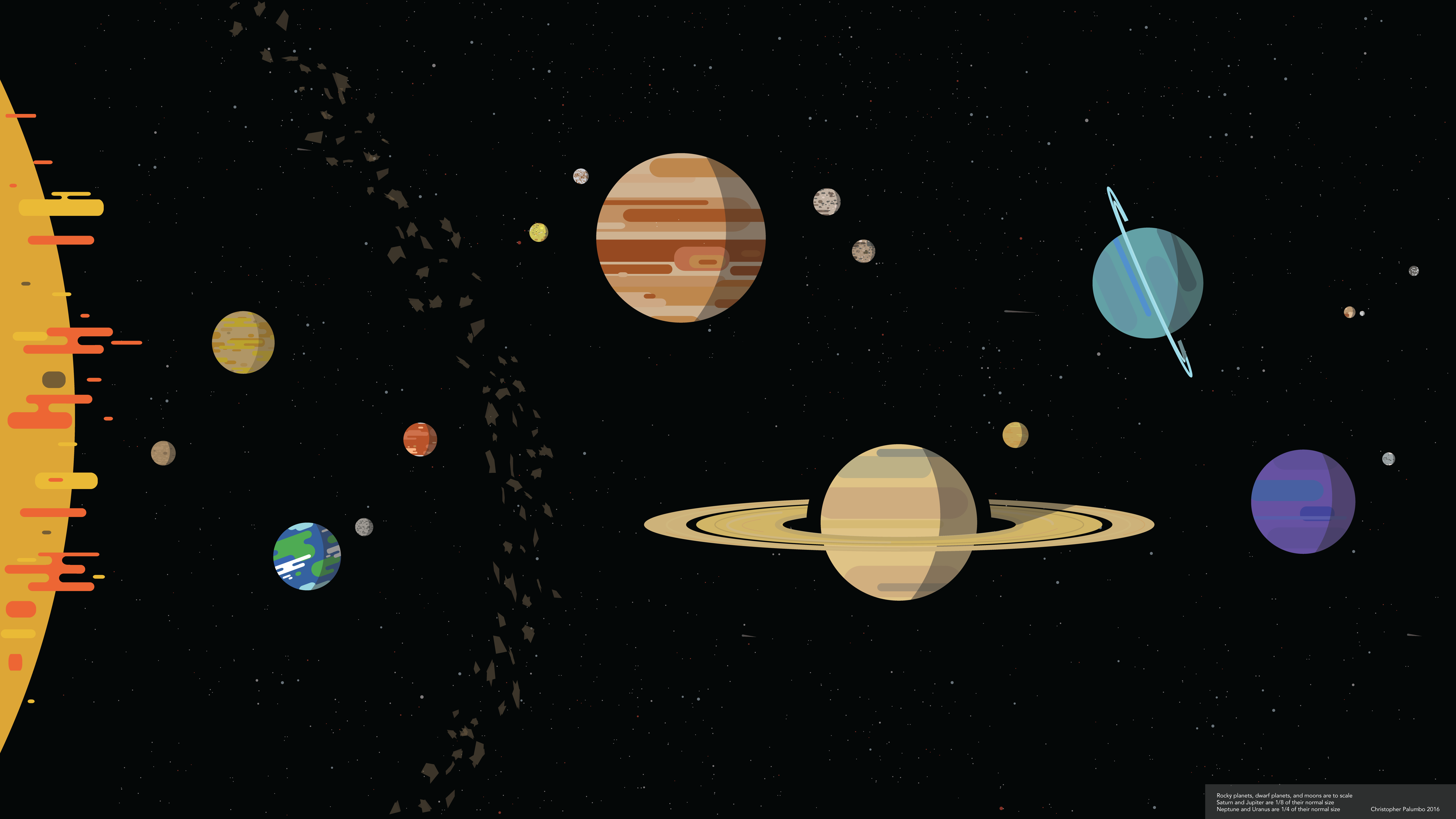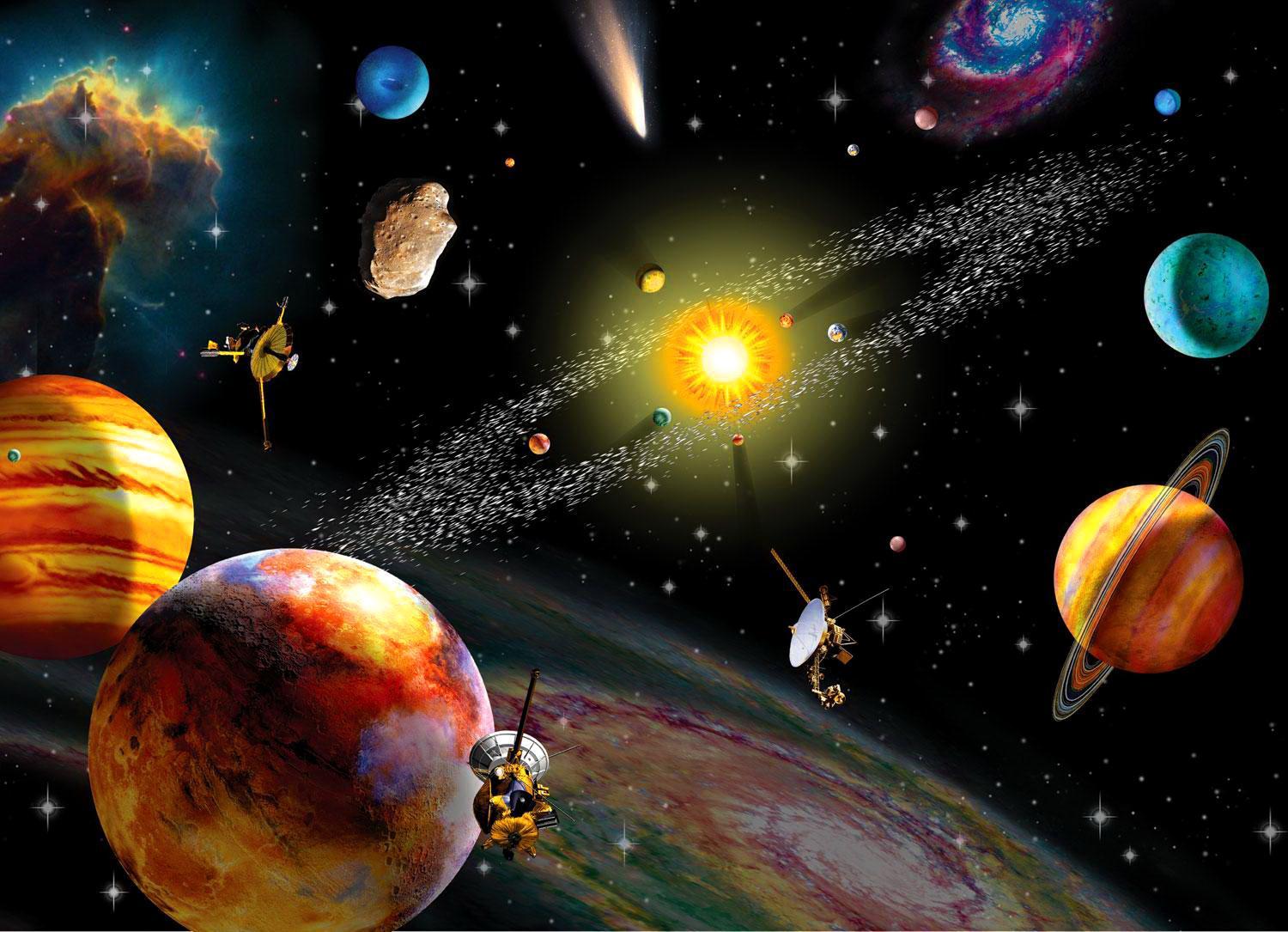Solar System Objects

The solar system comprises the Sun, eight planets, dwarf planets, and numerous moons, asteroids, comets, and meteoroids. Each celestial body possesses distinct characteristics that contribute to the intricate dynamics of our cosmic neighborhood.
Planets, Solar system wallpaper
Our solar system boasts eight planets, each orbiting the Sun in an elliptical path. These celestial bodies vary significantly in size, composition, and distance from the Sun.
- Mercury: The closest planet to the Sun, Mercury is a small, rocky world with a thin atmosphere. It experiences extreme temperature fluctuations, ranging from scorching highs during the day to frigid lows at night.
- Venus: Known as Earth’s “twin,” Venus is a terrestrial planet with a thick, carbon dioxide-rich atmosphere. Its surface is perpetually shrouded in clouds, rendering it the hottest planet in the solar system.
- Earth: Our home planet, Earth is a unique abode with a liquid water surface, a breathable atmosphere, and a diverse range of life forms. Its axial tilt and rotation give rise to seasons and weather patterns.
- Mars: Often referred to as the “Red Planet,” Mars is a terrestrial planet with a thin atmosphere and a rocky surface. Its polar ice caps and evidence of past water activity suggest the possibility of past or present life.
- Jupiter: The largest planet in our solar system, Jupiter is a gas giant composed primarily of hydrogen and helium. It boasts a distinctive Great Red Spot, a swirling storm that has persisted for centuries.
- Saturn: Another gas giant, Saturn is renowned for its magnificent ring system, composed of countless particles of ice and rock. Its rings extend for hundreds of thousands of kilometers, creating a breathtaking celestial spectacle.
- Uranus: An ice giant, Uranus is characterized by its unique axial tilt, which causes it to “roll” on its side as it orbits the Sun. Its atmosphere is composed primarily of hydrogen, helium, and methane.
- Neptune: The farthest planet from the Sun, Neptune is also an ice giant with a turbulent atmosphere. Its Great Dark Spot, a massive storm system, is comparable in size to the Earth.
Comparative Table
The following table compares the orbital periods, axial tilts, and surface temperatures of the planets in our solar system:
| Planet | Orbital Period (Earth days) | Axial Tilt (degrees) | Surface Temperature (°C) |
|---|---|---|---|
| Mercury | 88 | 0.01 | -173 to 450 |
| Venus | 225 | 177.3 | 462 |
| Earth | 365 | 23.4 | 15 |
| Mars | 687 | 25.2 | -63 to 20 |
| Jupiter | 4,333 | 3.1 | -110 |
| Saturn | 10,759 | 26.7 | -140 |
| Uranus | 30,685 | 98 | -200 |
| Neptune | 60,190 | 28.3 | -220 |
Significance of the Asteroid Belt and Kuiper Belt
The asteroid belt, located between the orbits of Mars and Jupiter, is a region of space containing millions of rocky bodies ranging in size from dust particles to small planets. It is believed to be the remnants of a failed planet that never fully formed.
The Kuiper belt, located beyond the orbit of Neptune, is a vast region of icy bodies, including comets and dwarf planets. It is thought to be a reservoir of primitive material left over from the formation of the solar system.
Both the asteroid belt and the Kuiper belt play important roles in the dynamics of our solar system. They provide insights into the early history of our solar system and serve as potential sources of future exploration and resource utilization.
Celestial Bodies and Phenomena: Solar System Wallpaper

Solar system wallpaper – The universe is vast and awe-inspiring, filled with celestial bodies and phenomena that have captivated human imagination for centuries. From the fiery brilliance of stars to the majestic grandeur of galaxies, each celestial object holds a unique story of formation, evolution, and significance in the cosmic tapestry.
Stars
Stars are celestial bodies that emit their own light and heat through nuclear fusion reactions in their cores. They are the building blocks of galaxies and play a crucial role in the chemical evolution of the universe.
Formation and Evolution
- Stars form from the gravitational collapse of massive clouds of gas and dust called nebulae.
- As the cloud collapses, it heats up and begins to rotate faster, forming a protostar.
- When the temperature and pressure at the center of the protostar become high enough, nuclear fusion begins, igniting the star.
- Stars evolve through different stages, depending on their mass and composition, eventually ending their lives as white dwarfs, neutron stars, or black holes.
Types of Stars
Stars are classified into different types based on their spectral characteristics, which are determined by their surface temperature and chemical composition.
- O-type stars are the hottest and most massive, with surface temperatures exceeding 30,000 Kelvin.
- B-type stars are also hot and massive, with surface temperatures ranging from 10,000 to 30,000 Kelvin.
- A-type stars are less massive and have surface temperatures between 7,500 and 10,000 Kelvin.
- F-type stars are even less massive, with surface temperatures between 6,000 and 7,500 Kelvin.
- G-type stars, like our Sun, have surface temperatures around 5,500 Kelvin.
- K-type stars are cooler than G-type stars, with surface temperatures between 3,500 and 5,000 Kelvin.
- M-type stars are the coolest and least massive, with surface temperatures below 3,500 Kelvin.
Galaxies
Galaxies are vast collections of stars, gas, and dust held together by gravity. They are the largest structures in the universe and come in a variety of shapes and sizes.
Characteristics and Behavior
- Galaxies are classified into different types based on their morphology, including elliptical, spiral, and irregular galaxies.
- Elliptical galaxies are round or oval in shape and have a smooth, featureless appearance.
- Spiral galaxies have a central bulge surrounded by a flat, rotating disk of stars and gas.
- Irregular galaxies have no definite shape and are often the result of mergers or interactions between other galaxies.
- Galaxies rotate and interact with each other, forming clusters and superclusters.
Distribution
Galaxies are not evenly distributed throughout the universe but are often found in clusters and superclusters.
- Clusters are groups of galaxies that are gravitationally bound together.
- Superclusters are even larger structures that contain multiple clusters of galaxies.
- The universe is estimated to contain billions of galaxies, each with its own unique characteristics and history.
Nebulae
Nebulae are vast clouds of gas and dust that are often found in the interstellar medium.
Types of Nebulae
- Emission nebulae are glowing clouds of gas that are ionized by the radiation from nearby stars.
- Reflection nebulae are clouds of dust that reflect the light from nearby stars.
- Planetary nebulae are shells of gas that are ejected by dying stars.
Nebulae play an important role in the formation of stars and planets and are often found in regions of active star formation.
Space Exploration and Technology

Space exploration is a relatively new field, but it has already made tremendous progress. In the past few decades, we have sent spacecraft to every planet in our solar system, and we have even landed humans on the moon. These missions have helped us to learn a great deal about our solar system and our place in it.
One of the most important milestones in space exploration was the launch of Sputnik 1, the first artificial satellite, in 1957. This event marked the beginning of the space race between the United States and the Soviet Union. In the years that followed, both countries sent a series of spacecraft to explore the solar system.
In 1961, the Soviet Union sent Yuri Gagarin into space, making him the first human to orbit the Earth. Just a few years later, in 1969, the United States sent Neil Armstrong and Buzz Aldrin to the moon, making them the first humans to walk on another celestial body.
Since then, we have continued to explore the solar system and beyond. We have sent spacecraft to Mars, Jupiter, Saturn, Uranus, and Neptune. We have also sent probes to study the sun, the comets, and the asteroids.
Space exploration has helped us to learn a great deal about our solar system and our place in it. It has also helped us to develop new technologies that have benefited us in many ways. For example, the satellites that we use for communication and navigation were originally developed for space exploration.
Spacecraft
There are many different types of spacecraft, each designed for a specific purpose. Some spacecraft are designed to orbit the Earth, while others are designed to travel to other planets. Some spacecraft are even designed to land on other planets or moons.
The most common type of spacecraft is the satellite. Satellites are used for a variety of purposes, including communication, navigation, and weather forecasting. Satellites can also be used to study the Earth’s surface and atmosphere.
Another type of spacecraft is the probe. Probes are used to explore other planets and moons. Probes can be equipped with a variety of instruments to study the surface, atmosphere, and magnetic field of a planet or moon.
Landers are spacecraft that are designed to land on other planets or moons. Landers can be equipped with a variety of instruments to study the surface of a planet or moon. Landers can also be used to collect samples of soil and rock.
Challenges and Advancements in Space Technology
Space exploration is a challenging endeavor. Spacecraft must be able to withstand the harsh conditions of space, including radiation, extreme temperatures, and micrometeoroids. Spacecraft must also be able to operate autonomously for long periods of time.
Despite the challenges, space exploration has made tremendous progress in recent years. We have developed new propulsion systems that allow spacecraft to travel faster and farther. We have also developed new life support systems that allow astronauts to live and work in space for extended periods of time.
As we continue to explore the solar system and beyond, we will face new challenges. However, we are confident that we will overcome these challenges and continue to make progress in our quest to understand the universe.
Indulge in the cosmic tapestry of solar system wallpaper, where planets dance across your walls like celestial ballet. For a touch of rustic charm, explore farmhouse wall art , its weathered textures and warm hues complementing the ethereal beauty of your celestial display.
Return to the celestial realm with solar system wallpaper, a constant reminder of our place amidst the vast expanse of the universe.
The solar system wallpaper adds a touch of cosmic wonder to your walls, reminding you of the vastness of the universe. Pair it with tall vase decor filled with vibrant blooms, creating a harmonious blend of celestial and earthly elements.
The juxtaposition of the expansive solar system with the grounded elegance of tall vases evokes a sense of balance and tranquility, making your room a haven of celestial and earthly beauty.